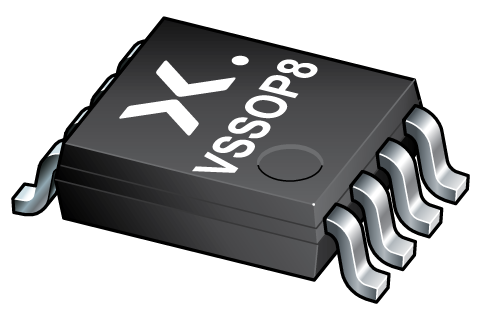
Register once, drag and drop ECAD models into your CAD tool and speed up your design.
Click here for more information74AHCT3G14GD
Triple inverting Schmitt trigger
The 74AHC3G14; 74AHCT3G14 is a triple inverter with Schmitt-trigger inputs. Inputs are overvoltage tolerant. This feature allows the use of these devices as translators in mixed voltage environments.
Alternatives
Features and benefits
Symmetrical output impedance
Wide supply voltage range from 2.0 V to 5.5 V
Overvoltage tolerant inputs to 5.5 V
Input levels:
For 74AHC3G14: CMOS level
For 74AHCT3G14: TTL level
High noise immunity
CMOS low power dissipation
Balanced propagation delays
Latch-up performance exceeds 100 mA per JESD 78 Class II Level A
ESD protection:
HBM: ANSI/ESDA/JEDEC JS-001 class 2 exceeds 2000 V
CDM: ANSI/ESDA/JEDEC JS-002 class C3 exceeds 1000 V
Multiple package options
Specified from -40 °C to +85 °C and -40 °C to +125 °C
Applications
Wave and pulse shaper for highly noisy environment
Astable multivibrator
Monostable multivibrator
参数类型
| 型号 | Package name |
|---|---|
| 74AHCT3G14GD | XSON8 |
封装
下表中的所有产品型号均已停产 。
| 型号 | 可订购的器件编号,(订购码(12NC)) | 状态 | 标示 | 封装 | 外形图 | 回流焊/波峰焊 | 包装 |
|---|---|---|---|---|---|---|---|
| 74AHCT3G14GD | 74AHCT3G14GD,125 (935286838125) |
Obsolete | C14 Standard Procedure Standard Procedure |

XSON8 (SOT996-2) |
SOT996-2 | SOT996-2_125 |
文档 (5)
| 文件名称 | 标题 | 类型 | 日期 |
|---|---|---|---|
| 74AHC_AHCT3G14 | Triple inverting Schmitt trigger | Data sheet | 2023-09-05 |
| AN10161 | PicoGate Logic footprints | Application note | 2002-10-29 |
| AN11106 | Pin FMEA for AHC/AHCT family | Application note | 2019-01-09 |
| Nexperia_package_poster | Nexperia package poster | Leaflet | 2020-05-15 |
| SOT996-2 | plastic, leadless extremely thin small outline package; 8 terminals; 0.5 mm pitch; 3 mm x 2 mm x 0.5 mm body | Package information | 2020-04-21 |
支持
如果您需要设计/技术支持,请告知我们并填写 应答表 我们会尽快回复您。
模型
No documents available
How does it work?
The interactive datasheets are based on the Nexperia MOSFET precision electrothermal models. With our interactive datasheets you can simply specify your own conditions interactively. Start by changing the values of the conditions. You can do this by using the sliders in the condition fields. By dragging the sliders you will see how the MOSFET will perform at the new conditions set.

